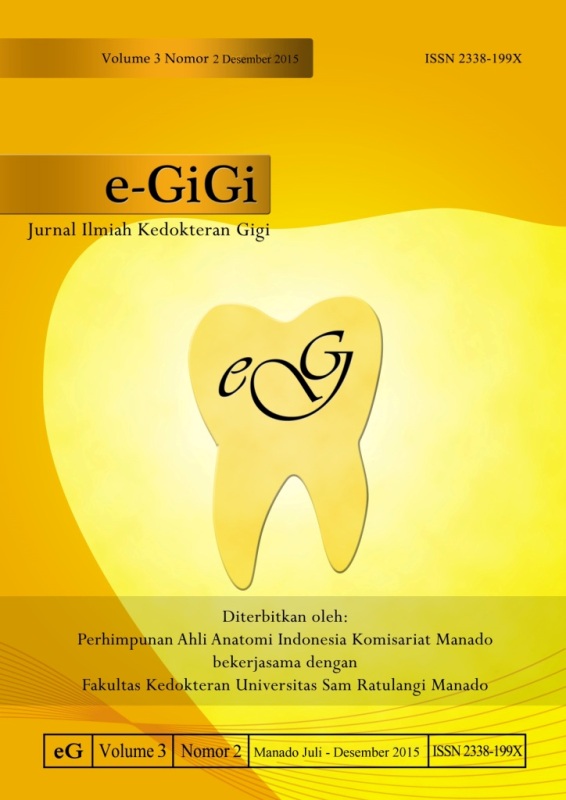GAMBARAN STATUS KARIES PADA ANAK BERKEBUTUHAN KHUSUS DI SLB YPAC MANADO
DOI:
https://doi.org/10.35790/eg.3.2.2015.10485Abstract
Abstract: Dental caries is the most commonly oral disease found in all layers of society, including children with special needs. Some researchers mentioned that high rates of dental caries in children with special needs such as hearing impairment, physical impairment, and mental impairment were caused by their limitation in doing their daily activities. This study aimed to determine the status of dental caries in children with special needs. The index commonly used to access the status of caries is DMF-T. Samples were children with special needs aged 12-17 years old in SLB YPAC Manado. There were 36 children as samples obtained by using the total sampling method. The results showed that the caries status of children with special needs in SLB YPAC Manado with an average DMF-T index 4.4 was in middle category.
Keywords:caries status, children with special needs, DMF-T
Abstrak: Karies gigi merupakan penyakit gigi dan mulut yang sering ditemukan di seluruh lapisan masyarakat termasuk pada anak berkebutuhan khusus. Beberapa penelitian menyebutkan bahwa tingginya angka karies gigi pada anak berkebutuhan khusus seperti tunarungu, tunadaksa dan tunagrahita, disebabkan karena mereka memiliki keterbatasan dalam melakukan aktivitas sehari-hari. Penelitian ini bertujuan untuk mengetahui bagaimana gambaran status karies gigi pada anak berkebutuhan khusus. Indeks yang umum digunakan untuk menilai status karies ialah indeks DMF-T. Penelitian ini dilakukan pada anak berkebutuhan khusus umur 12-17 tahun di SLB YPAC Manado dengan jumlah sampel sebanyak 36 siswa. Teknik pengambilan sampel menggunakan metode total sampel. Hasil penelitian menunjukkan status karies gigi pada anak berkebutuhan khusus di SLB YPAC Manado dengan indeks DMF-T sebesar 4,4 termasuk kategori sedang.
Kata kunci: status karies, anak berkebutuhan khusus, DMF-T
Downloads
How to Cite
Issue
Section
License
COPYRIGHT
Authors who publish with this journal agree to the following terms:
Authors hold their copyright and grant this journal the privilege of first publication, with the work simultaneously licensed under a Creative Commons Attribution License that permits others to impart the work with an acknowledgment of the work's origin and initial publication by this journal.
Authors can enter into separate or additional contractual arrangements for the non-exclusive distribution of the journal's published version of the work (for example, post it to an institutional repository or publish it in a book), with an acknowledgment of its underlying publication in this journal.
Authors are permitted and encouraged to post their work online (for example, in institutional repositories or on their website) as it can lead to productive exchanges, as well as earlier and greater citation of the published work (See The Effect of Open Access).






